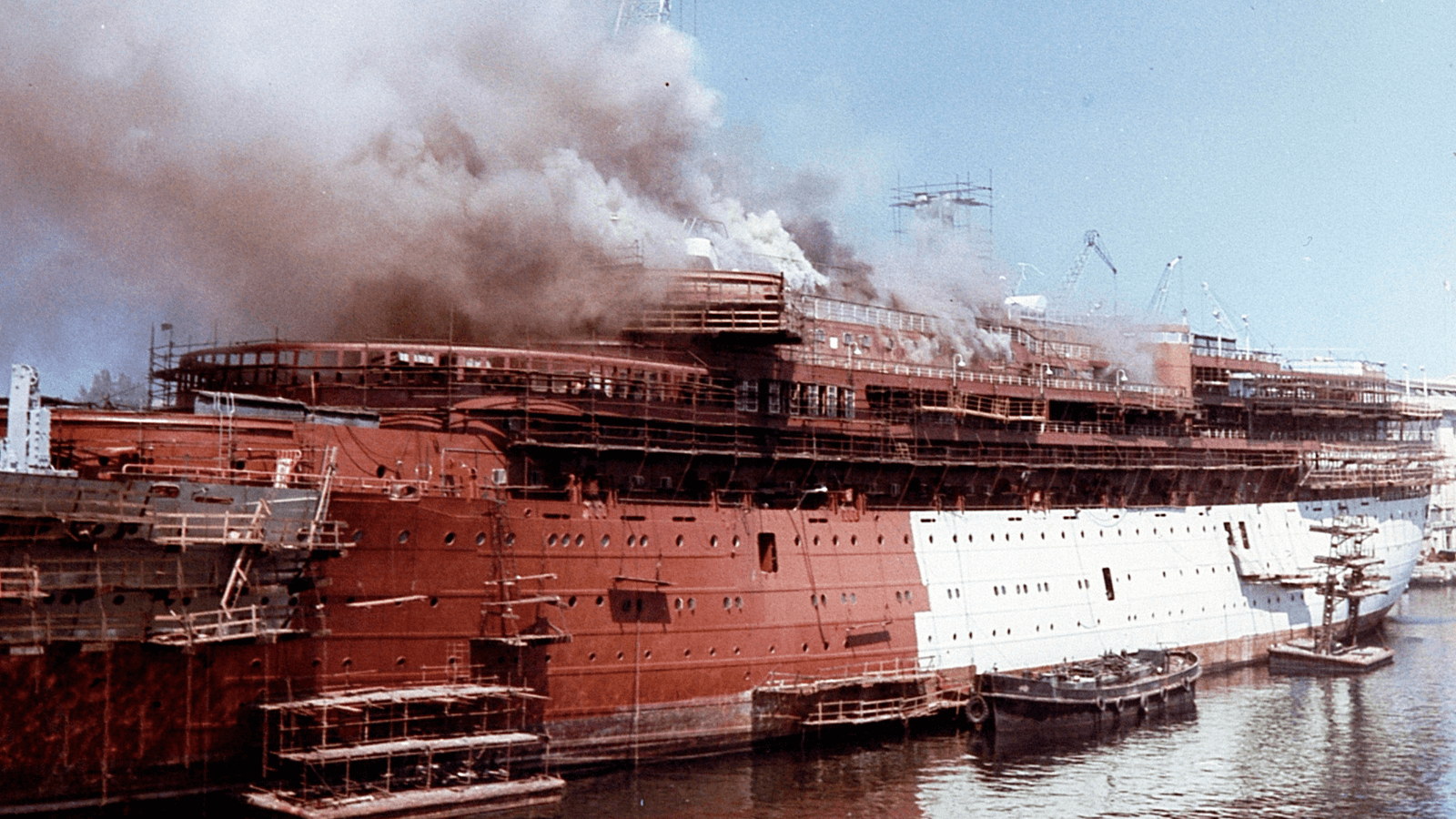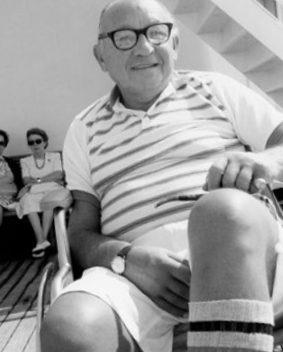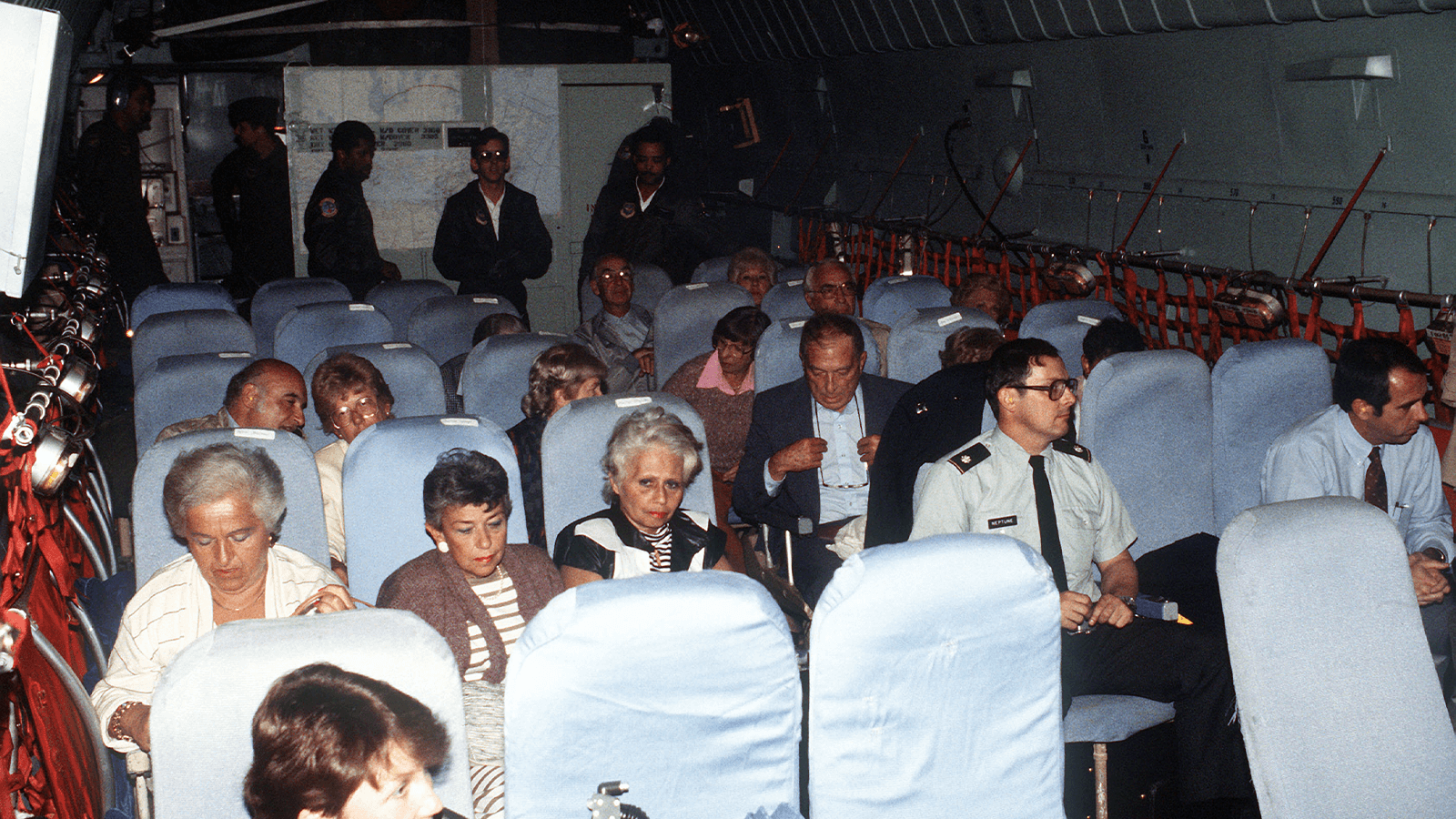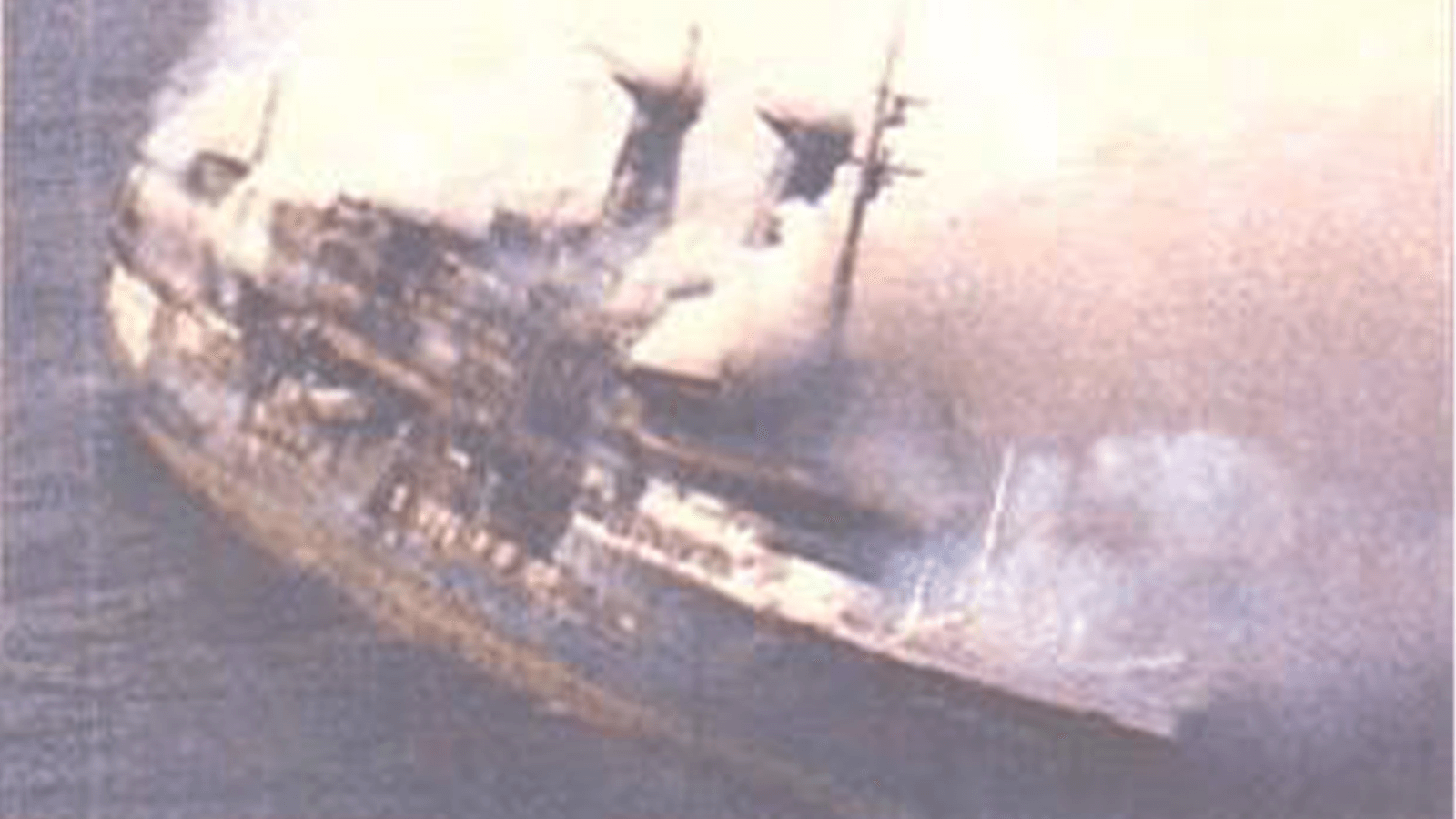
MS Achille Lauro: The cursed liner destined for hijack and murder
The crew and passengers of MS Achille Lauro - an Italian luxury cruise liner - were held hostage for three days by Palestinian gunmen in the Red Sea. But, as it turns out, the ship's timeline masked a chequered history of which the political drama wasn't even the climax
Providing complimentary fruit rarely presents much drama for cruise ship staff. It’s a clean-cut case of delivering a basket of goodness, before toddling off and engaging with the remainder of the day.
That is, unless you stumble upon four startled young men, feverishly cleaning petrol off their machine guns – using a hairdryer – who plan to hold the ship and her inhabitants hostage, hoping to spark a vicious and bitter political crisis capable of engulfing multiple nations.
Sounds like something out of a Monty Python sketch, yet that exact scenario played out for a young steward onboard a cruise ship off the coast of Alexandria, Egypt. Upon opening the cabin door and offering gratis snacks, all hell broke loose.
The date was October 7, 1985, and the ship happened to be the luxurious MS Achille Lauro, a 40-year-old passenger liner with a rather chequered history. The cabin-dwelling gun enthusiasts happened to be Palestinian militants, hailing from refugee camps in Lebanon and Jordan.
These men were operatives of the radical Palestine Liberation Front; people not to be messed with. They weren’t on holiday, either. PLF militants intended to hijack the Lauro – and their actions would culminate in the violent murder of an innocent disabled Jewish passenger.
However, the ship’s curse wouldn’t stop there. As you’ll discover, it’s fair to say that Lauro was far from the most fortunate. While God clearly kept an eye on other vessels, dark forces ensured that MS Achille Lauro met with a grizzly fate before descending into the depths almost 130 miles from shore.
She has yet to be found, instead lingering in the lonesome void at 4,000 meters in the Arabian Sea. The ship's quiet grave is unlikely to be disturbed anytime soon.

Difficult Beginnings
Nobody could have foreseen the events that awaited IMO hull number 5390008 (later to be the MS Achille Lauro), ordered in 1938 and laid down the following year. Although the build process had proven far from straightforward, hopes were high for the stylish craft and all who sailed in her.
Interrupted by two bombing raids during WWII, the vessel was finally completed as the Willem Ruys in 1946 for the Dutch East Indies service. Boasting a capacity of 900 passengers and taking centre stage for fashionable ocean-going travel, the ship quickly became an icon of post-war maritime success.
Willem Ruys' high-profile passengers during those early years included novelist and journalist Vita Sackville-West and her husband, the diplomat Harold Nicholson, alongside a fresh-faced Singaporean undergraduate by the name of Lee Kuan Yew – later to become the founding Prime Minister of Singapore.
The ship’s first cruise operations proved to be profitable and fortunate, but then events took a turn for the worst. The first calamity occurred on January 6, 1953, the same day as the first Asian Socialist Conference opened in Burma.
While cruising across the Red Sea, Willem Ruys collided with Oranje - her sister ship - sailing in the opposite direction at an unexpectedly fast pace. There was no loss of life or serious injury, and the incident was chalked up to miscommunication. Yet, sinister forces were only getting warmed up for the main event.
The ship was eventually sold to an Italian line and named after the company’s high-brow owner - Achille Lauro (1887-1984) - the former mayor of Naples and a popular force within Italian politics.

Following various celebrations that trumpeted the newly-christened vessel, MS Lauro didn’t hang around long before causing mayhem. Suffering a catastrophic fire while undergoing extensive re-fitment works in 1972, the ship was almost destroyed. It took biblical efforts to save the ship from herself, endangering dozens of lives and undoing the efforts of a shipyard’s labour force.
Not quite content with that, the liner then sank a Lebanese cargo ship three years later during a collision, before yet again catching fire in 1981.
The foreboding curse then set to work on the Lauro Line itself, which went bankrupt the following year, and the vessel – now showing her age - fell into the hands of a Greek firm, but not until she spent a year impounded in the Canaries due to unpaid debts.
The Atlantic sun rose no less than 365 times over the deserted vessel before passengers finally stepped aboard once more.
Following a peaceful run of good luck under a Greek flag, she set out from Genoa in the autumn of 1985 for an itinerary around the Eastern Mediterranean.
Destined for Ashdod in Israel, it should have been an easy and profitable journey, but fate had other plans in store. And it started with a complimentary delivery of a fruit basket.

Political Turmoil
Unbeknownst to passengers or crew on the Ashdod cruise, four members of the PLF - Youssef Majed al-Molqi, Bassam al-Achkar, Ibrahim Abdelatif, and Ahmad al-Assadi – had disguised themselves as Argentinian tourists.
Except, rather than relaxing and taking in the scenery, the aggressive sub-faction of the Palestine Liberation Organisation has chaos in mind. Muhammad Zaidan, the PLF’s leader and sometime associate of Yasser Arafat (who went by the nom de guerre Abu Abbas), had spent 11 months planning an operation as ambitious as it was ruthless. All he required was a white cat to complete the ‘supervillain’ package.
Should you delve into the history books, 1985 had been a tumultuous year for the PLF. That season’s activities had included expulsion from Damascus, vicious infighting in the Lebanese camps, and a lethal IDF strike on their Tunis headquarters. Abbas would later be accused of trying to undermine Arafat’s leadership, at the expense of civilian lives.
In keeping with the PLF’s greatest hits, the hijackers of MS Achille Lauro intended to launch an armed and suicidal attack on the Israeli port of Ashdod, using the cruise ship’s arrival as cover.
Oblivious passengers set to become hostage fodder included a group of friends and relatives from New York, taking a cruise holiday to celebrate the 58th birthday and 36th wedding anniversary of Jewish-American publishing manager Marilyn Klinghoffer.
They had chosen the Lauro as the vessel most accessible for Marilyn’s husband, Leon, who was reliant on a wheelchair following two strokes. It was the day after Marilyn’s birthday when Achille Lauro called into Alexandria, and 651 passengers left the ship for a tour of the pyramids, intending to rendezvous with the ship at Port Said later in the day.
Some 97 passengers - mostly disabled and elderly - and the hairdryer-abusing militants, remained onboard. Several eyewitnesses would later recount suspicious activity in Alexandria, including a car arriving with several unmarked packages, believed to be the source of the weapons.
Once the ship left Alexandria, events would quickly spiral out of control. The steward’s surprise discovery led to the abandonment of the original plan, and the immediate - if not premature - hijacking of the cruise ship.
Hijacking and Murder
The four terrorists stormed Lauro’s dining lounge halfway through dinner, announcing their presence with a volley of gunfire above the passengers’ heads.
Chaos ensued; passengers and kitchen staff attempted to flee, only to run directly into the militants, with one Austrian tourist being shoved down a flight of stairs.
The captain, Gerardo de Rosa, was hailed by the crew and attempted to intervene, but was confronted and held at gunpoint by one of the hijackers on the bridge. The PLF had seized the Lauro. And it would be theirs for a solid stretch of time.
As some semblance of order began to emerge, de Rosa was ordered to sail for the Syrian port of Tartus, 300 miles to the northeast, and the passengers were herded into the dining room as hostages.
To keep control and intimidate any have-a-go heroes, the terrorists lied about their numbers and claimed that there were 20 armed men onboard the ship.
The hijackers swung erratically between courtesy and cruelty at the drop of a hat, volunteering to wash a passenger’s plates for them one minute, before striking them with a gun stock to usher them between rooms.

By the following day, foreign governments whose citizens were onboard the Lauro had been alerted to the crisis. A response haphazardly came together, centred on the British military base at Akrotiri.
The U.S. State Department began to frantically negotiate with the Italian government and neighbouring countries, while the Pentagon dispatched special forces to Europe, and the Italians mobilised troops and negotiators in Cyprus while opening dialogue with Arab governments and the PLO.
Onboard the cruise ship, meanwhile, the terrorists separated 20 British, American, Austrian and Jewish hostages onto the upper deck – including Leon and Marilyn Klinghoffer.
At 11.00am on Tuesday, the Lauro reached Tartus, and al-Molqi radioed the Syrian authorities. He demanded the right to dock at the port, and the release of 50 Palestinian prisoners held by the Israeli government – or they would begin shooting hostages at “3.00 pm sharp”.
As the deadline neared, the Syrians were unresponsive, and the hijackers decided to murder Leon Klinghoffer first.
Al-Molqi would later insist that the choice was not a product of antisemitic hatred, but rather to send a message to the American government, and to demonstrate – by executing an invalid – that the terrorists were willing to cross any line in pursuit of their goals.
In light of reports by other Jewish passengers of mistreatment and abuse at their hands, historians find this a thin excuse. Klinghoffer was moved to the stern deck and shot in the head and chest by al-Molqi, who ordered two crewmen to then throw him and his wheelchair overboard.

Negotiations
With Syria refusing to negotiate, the hijackers told De Rosa to head for Libya; before this could happen, Abu Abbas contacted his subordinates through a Cypriot radio station.
The PLF commander ordered them to treat the hostages well, to refrain from any further violence, and to sail immediately for Port Said, where negotiations would take place - led by a joint Italian-Egyptian team with Palestinian observers.
Arafat - who denounced the hijacking and claimed no foreknowledge of the PLF’s plans – nonetheless allowed Abbas to join a joint Italian-Egyptian team as one of the PLO’s representatives, and on Wednesday morning negotiations for the release of the hostages and the surrender of the hijackers began in Port Said harbour.
Amid a flurry of negotiations brokered by the Italians and the Egyptians, with the U.S. preparing a military option in the background, the terrorists disembarked into Egyptian custody.
Lauro’s passengers had been freed, but the situation was still extremely tense – made even more so by the discovery of Leon Klinghoffer’s death, to the horror of his family & fellow passengers, and the outrage of Western governments.

Italy requested that the hijackers be transferred to their jurisdiction, while Israel and America demanded their immediate trial for piracy, terrorism and murder.
Controversies and intrigue rapidly sprung up about the Lauro crisis, as national governments, militant groups, and other competing interests fought over jurisdiction, responsibility and blame.
The Egyptian president Mubarak, attempting to maintain good relations with the West, Israel, & the Arab world, decided to let the terrorists leave for Tunis, following promises of a fair and speedy trial in a third-party nation by the PLO.
However, the plane carrying the hijackers was intercepted by U.S. fighter jets on the orders of US President Ronald Reagan, and escorted to an American naval base at Sigonella in Italy.

A Fierce Ending
At Sigonella, a fraught standoff took place between American special forces and Italian military police. Both claimed jurisdiction over the four Palestinians, and the three-way confrontation lasted five hours until, eventually, the U.S. conceded, allowing the Carabinieri to arrest the militants.
The geopolitical carnage unleashed by the events aboard Lauro did not end there. Relations between America, Italy and Egypt would be poisoned for some years by the incident, each accusing the other of overstepping their bounds.
The hijackers were tried in Italy, receiving sentences between 15 and 30 years, though several would later flee or disappear while on parole; Abu Abbas fled to Yugoslavia and disappeared for several decades, only to be captured by the U.S. during the invasion of Iraq in 2003, dying in custody a year later.
Even once the dust was settled, the MS Achille Lauro’s career – and her troubles – were not over. Continuing in service for nearly a decade, the cruise ship would meet her end on November 30, 1994, off the coast of Somalia, catching fire after an unsupervised crankcase exploded in the engine room and set the cooling oil alight.
Crew and passengers unsuccessfully attempted to fight the fire with bucket chains from the ship’s swimming pool, before abandoning the ship, piling into lifeboats and clambering down rope ladders as flames licked up her listing sides.
Two passengers died and eight were injured in the hasty evacuation; the majority were soon picked up by passing cargo ships and American naval vessels.

Among the passengers – in a bizarre stroke of coincidence – were Moss and Tracy Hills, who had led rescue efforts aboard the MTS Oceanos three years earlier, and took on a similar role in 1994.
MS Achille Lauro was hijacked close to 40 years ago, and the world of cruising is today a fundamentally different place. Politically-motivated hijackings of planes and ships, so commonplace in the 1980s, are far rarer today, and cruise travel is as safe as it has ever been.
But many of the tensions that contributed to the Lauro crisis remain unresolved to this day, with politically-motivated violence disrupting regional economies and deterring tourism. While threats to the lives of cruisegoers are mercifully rare, the same unfortunately cannot be said for the residents of conflict-prone regions.
The crisis also highlights the multinational dimension of cruising – and how responsibility ought to be shared out when things go wrong. When a citizen of one country is murdered aboard a ship owned by a second in the territorial waters of a third, by a stateless assailant, whose duty is it to arrest them, and where should the trial be held?
At the best of times, maritime jurisdiction is a contentious issue; when lives are on the line, things can become downright rancorous.
There are few easy answers to any of these questions. All the same, to understand the modern cruise industry, it remains important to remember the intersection between international travel, global diplomacy, and political violence – and its human cost – as demonstrated so aptly by the unfortunate career of Achille Lauro.
Never has citrus been so political. You’ll never look at a fruit basket the same way again.

